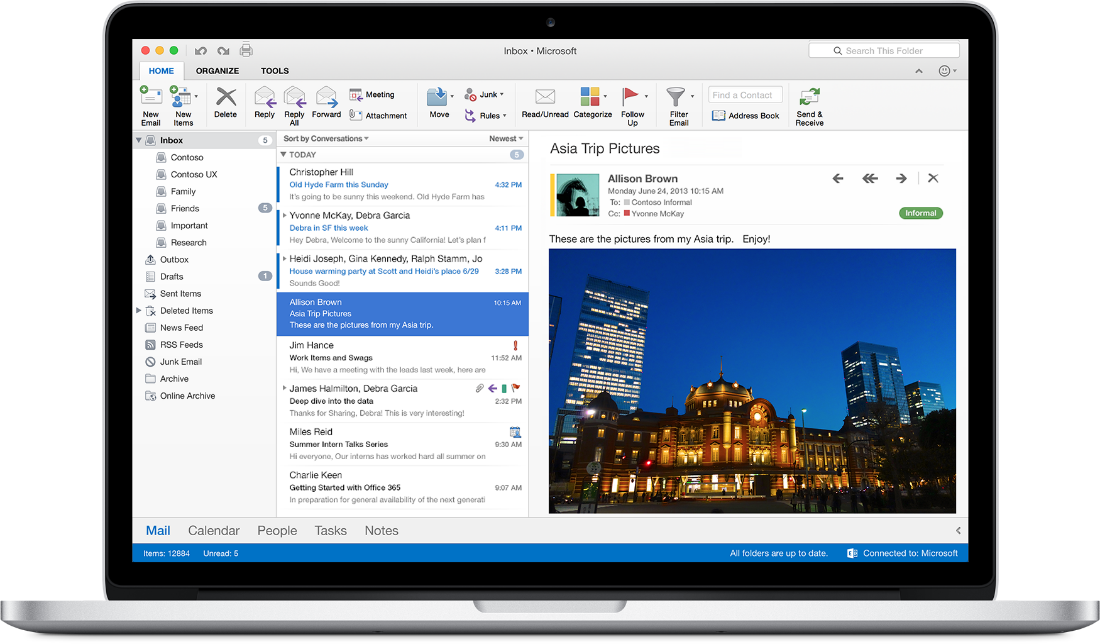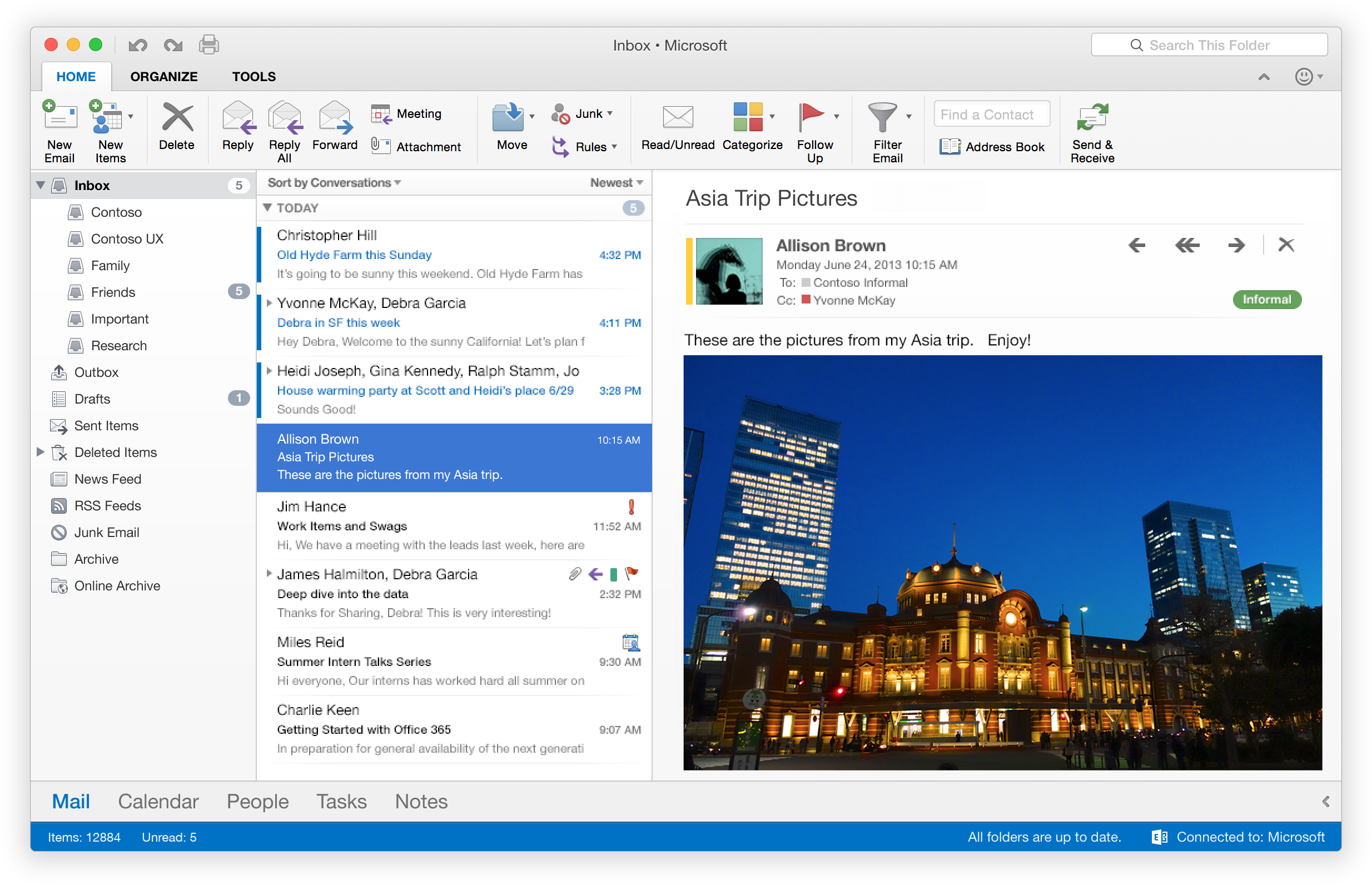Microsoft Office 2016 - Unmistakably Office, designed for Mac. The new versions of Word, Excel, PowerPoint, Outlook, and OneNote provide the best of both worlds for Mac users - the familiar Office experience paired with the best of Mac. If you already use Office on a PC or iPad, you will find yourself right at home in Office 2016 for Mac. Microsoft Office 2016 - Unmistakably Office, designed for Mac. The new versions of Word, Excel, PowerPoint, Outlook and OneNote provide the best of both worlds for Mac users - the familiar Office experience paired with the best of Mac. If you already use Office on a PC or iPad, you will find yourself right at home in Office 2016 for Mac. Office 2016 for Mac, like most Microsoft products, has a support lifecycle during which we provide new features, bug fixes, security fixes, and so on. This lifecycle typically lasts for 5 years from the date of the product’s initial release. For more information about the support lifecycle for Microsoft products, see Microsoft Lifecycle Policy. Microsoft clarified this important point for many Mac users stating: The requirements for connecting to Office 365 services have also changed—and customers will now need Microsoft 365 Apps, Office 2019, or Office 2016 to connect to Office 365 services like Exchange Online and SharePoint Online. While we will not take any active measures to.
-->Note
Office 365 ProPlus is being renamed to Microsoft 365 Apps for enterprise. For more information about this change, read this blog post.
Summary
Existing Office 2016 for Mac customers will be seamlessly upgraded to 64-bit versions of Word, Excel, PowerPoint, Outlook, and OneNote as part of the August product release (version 15.25). This affects customers of all license types: Retail, Office 365 Consumer, Office 365 Commercial, and Volume License installations.
Deployment options for the 64-bit update
AutoUpdate (MAU)
Customers who use Microsoft AutoUpdate (MAU) to keep their Office applications up-to-date will see a 'regular' monthly update notification when their selected channel is upgraded to 64-bit builds. Depending on which version is installed on the local computer, MAU will offer either a delta or full update. The update package size does not change between 32-bit and 64-bit versions. Also, MAU can deliver a delta update when applicable to update a user from 32-bit to 64-bit applications. Therefore, customers won't experience a sharp increase in download activity. For the release to the Production channel, customers will see '(64-bit)' in the update title to make them aware that this is a 64-bit update.
For information about how to use the MAU, see Check for Office for Mac updates automatically.
Manual updates
The August release of Office for Mac is available for manual download. The following file provides a 64-bit package to replace existing 32-bit applications with 64-bit variants during installation:
Download the Microsoft Office 2016 for Mac August update package now.
Virus-scan claim

Microsoft Outlook For Mac 2016
Microsoft scanned this file for viruses, using the most current virus-detection software that was available on the date that the file was posted. The file is stored on security-enhanced servers that help prevent any unauthorized changes to it.
Volume License Service Center
Volume License customers typically get their Office 2016 software from the Volume License Service Center (VLSC). These builds are refreshed infrequently and are typically aligned with new language editions. The VLSC will continue to offer 32-bit installers (15.23) until November 2016. However, all updater packages that are released after August will be based on 64-bit builds. Therefore, a VLSC customer who updates either manually or through AutoUpdate will be transitioned to 64-bit builds.
More Information
64-bit only
The Mac operating system has been 64-bit for several years. Unlike for Windows, there's no choice between running a 32-bit or 64-bit version of the Mac operating system. Similarly, we won't offer a choice between 32-bit and 64-bit versions of Office 2016 for Mac. After each 'channel' is transitioned per the rollout schedule, only 64-bit builds will be available.
Effect on third-party applications and add-ins
The transition to 64-bit Office for Mac was announced in April 2016. IT Pros will want to understand which compiled add-ins are deployed to the users whom they manage so that they can assess the effect of the upgrade. The following Microsoft Office website summarizes the issues that affect the more common add-ins that are used together with Office 2016 for Mac:
Tools for inspecting product architecture

To verify the architecture of an Office application (that is, to understand whether you have a 32-bit or 64-bit build), start the application, open the Activity Monitor, and then enable the Kind column.
You can also use the file command in a terminal session to inspect the binary. For this use, type file -N <path of binary>.This method can be used with for any binary file, including third-party add-ins.
The file command returns one of three values.
| Return value | Meaning |
|---|---|
| Mach-O 64-bit executable x86_64 | 64-bit binary |
| Mach-O executable i386 | 32-bit binary |
| Mach-O 64-bit executable x86_64 | FAT binary (compatible with both 32-bit and 64-bit processes) |
| Mach-O executable i386 | FAT binary (compatible with both 32-bit and 64-bit processes) |
Options for reverting to 32-bit installations
Office 2016 Mac Outlook Profile Location
There may be situations in which the customer has to change code that's not 64-bit ready. If customers can't immediately move forward to 64-bit builds, we will make available a one-time 32-bit update for the 15.25 release in addition to the default 64-bit updates. The 32-bit updates will be available only for manual download from the Office CDN.
The latest 32-bit release of Office 2016 for Mac (15.25.160818) can be downloaded from https://go.microsoft.com/fwlink/?LinkId=823192.
Customers who manually install the 32-bit release won't be offered the 64-bit version of 15.25 through MAU. However, MAU will offer the 64-bit version of 15.26 in September 2016. Therefore, customers have a limited time to remain on 32-bit builds.
If a customer has already upgraded to the 64-bit update of Office for Mac 15.25 and wants to revert to the 32-bit version, follow these steps:
- Exit all open Office 2016 applications.
- Start Safari, and then browse to https://go.microsoft.com/fwlink/?LinkId=823192 to start the download of the 32-bit installer.
- Double-click the downloaded package, and then follow the instructions.
The 64-bit installation has a build date of 160817. The 32-bit version has a build date of 160818.
Today we mark the end of support for Office 2010 and Office 2016 for Mac. This means that we’ll no longer provide technical support, bug fixes, or security updates for these products, and organizations that continue to use them may face increased security risks and compliance issues over time. The requirements for connecting to Office 365 services have also changed—and customers will now need Microsoft 365 Apps, Office 2019, or Office 2016 to connect to Office 365 services like Exchange Online and SharePoint Online. While we will not take any active measures to block legacy versions of the Office client from connecting, these older clients will fall out of step with the service enhancements and may present performance and/or reliability issues over time.

As we first announced back in April 2017, this decision aligns with our broader commitment to providing tools and experiences designed for a new world of work. If this year has taught us anything, it’s that we need to help our customers stay agile and connected despite constant change. And that means delivering cloud-connected and always up-to-date versions of our most valuable apps to every person and every organization on the planet. With Microsoft 365 Apps, we do that in three big ways. First, the cloud enables real-time collaboration across apps and within Microsoft Teams, the hub for teamwork. Second, AI and machine learning advance creativity and innovation in everything from PowerPoint design to Excel analysis. And finally, built-in, cloud-powered security protects your data and provides the peace of mind that comes with knowing your business will not only be productive, but also secured.
Outlook For Mac 2016 Download
We understand that everyone is at a different stage of their journey to the cloud, and we’re committed to supporting our customers throughout their transition to Microsoft 365 Apps. For those customers who aren’t ready for the cloud and have a specific need for on-premises or hybrid deployment, such as fully disconnected or restricted environments, we offer Office 2019, the perpetual version of Office that does not receive feature updates. But for everyone else, we’ve created a set of resources to help you transition to the Microsoft 365 Apps and innovations designed to help keep your environment up to date once you’ve made the transition.
Resources for transitioning to Microsoft 365 Apps
Transitioning to the always up-to-date Microsoft 365 Apps has never been easier. Here’s a list of resources available to help.
- The Office 2010 end of support roadmap is a great place to start your migration, walking you through the steps you’ll need to take and the resources available at each stage.
- The Deployment Guide for Microsoft 365 Apps provides the most up-to-date deployment and servicing guidance, including guidance on how to use the Readiness Toolkit to help you identify compatibility issues with Office add-ins and Microsoft Visual Basic for Applications (VBA) macros.
- For customers using Microsoft Endpoint Configuration Manager, the Microsoft 365 Apps upgrade readiness dashboard shows which devices in the environment are ready to upgrade to Microsoft 365 Apps, including add-in and macro compatibility.
- Research from more than 500 organizations demonstrates that customers who have taken the journey to Microsoft 365 are seeing productivity, security, and management benefits from the integrated solution. Download this eBook to learn more about their experiences, and the business impact they’ve seen to date.
- Microsoft FastTrack experts and the App Assure program are available for customers who need added assistance and can work with you to roll out Microsoft 365 Apps to your entire organization.
New resources to help keep your environment up to date
We also recently announced a host of innovations geared toward empowering people, teams, and organizations to thrive in the new world of work. Rolling out in the coming months, two of these—Office Inventory and Servicing Profile—will be especially helpful in keeping your environments up to date once you’ve transitioned to Microsoft 365 Apps.
- Office Inventory allows you to drill into detailed views of devices running Office apps in your environment. Use it to understand which Office client versions and Office add-ins are running as well as which servicing channel each device belongs to. Customers who are still transitioning to Microsoft 365 Apps can use this tool to understand where to target their efforts as they go.
- The new Servicing Profile feature helps streamline and automate Microsoft 365 Apps servicing, reducing the burden of manual deployments and accelerating the rollout of the latest productivity features and security patches without adding extra effort and costs. You can learn more about Office Inventory, Servicing Profile, and more new admin capabilities on the Office 365 Blog or by watching this session from Microsoft Ignite.

All of our customers are working hard to help their people stay productive, connected, and secure at a time of rapidly accelerated digital transformation. Microsoft 365—which includes Teams and Microsoft 365 Apps, along with tools like OneDrive for Business and built-in management, security and compliance—helps ensure your people can do their best work while also remaining secure. And we are committed to investing in Microsoft 365 for the long haul, delivering ever-improving experiences that empower individuals, teams, and organizations to achieve more today and in the days to come.
